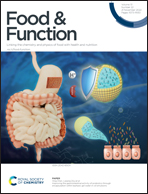Co-encapsulation of quercetin and resveratrol in zein/carboxymethyl cellulose nanoparticles: characterization, stability and in vitro digestion
Abstract
Oral administration of combinations of specific nutrients and nutraceuticals can provide synergistic health benefits to humans. In this work, zein/carboxymethyl cellulose composite nanoparticles were successfully prepared using antisolvent precipitation methods. Zein/carboxymethyl cellulose nanoparticles with the smallest size (204.6 nm) were formed when the mass ratio of zein to CMC was 2 : 1. Hydrogen bonding and hydrophobic interactions were dominant binding forces to stabilize the composite nanoparticles. Quercetin and resveratrol were then encapsulated within these nanocarriers, which improved their resistance to both light and thermal degradation. Encapsulation of the nutraceuticals was shown to delay their release under simulated gastrointestinal conditions, which may be beneficial for some applications. Moreover, encapsulation increased the in vitro bioaccessibility of the quercetin and resveratrol. Our results indicate that zein/carboxymethyl cellulose nanoparticles can be used to co-deliver combinations of bioactive compounds, which may be useful for the development of functional foods, supplements, and pharmaceuticals.



 Please wait while we load your content...
Please wait while we load your content...